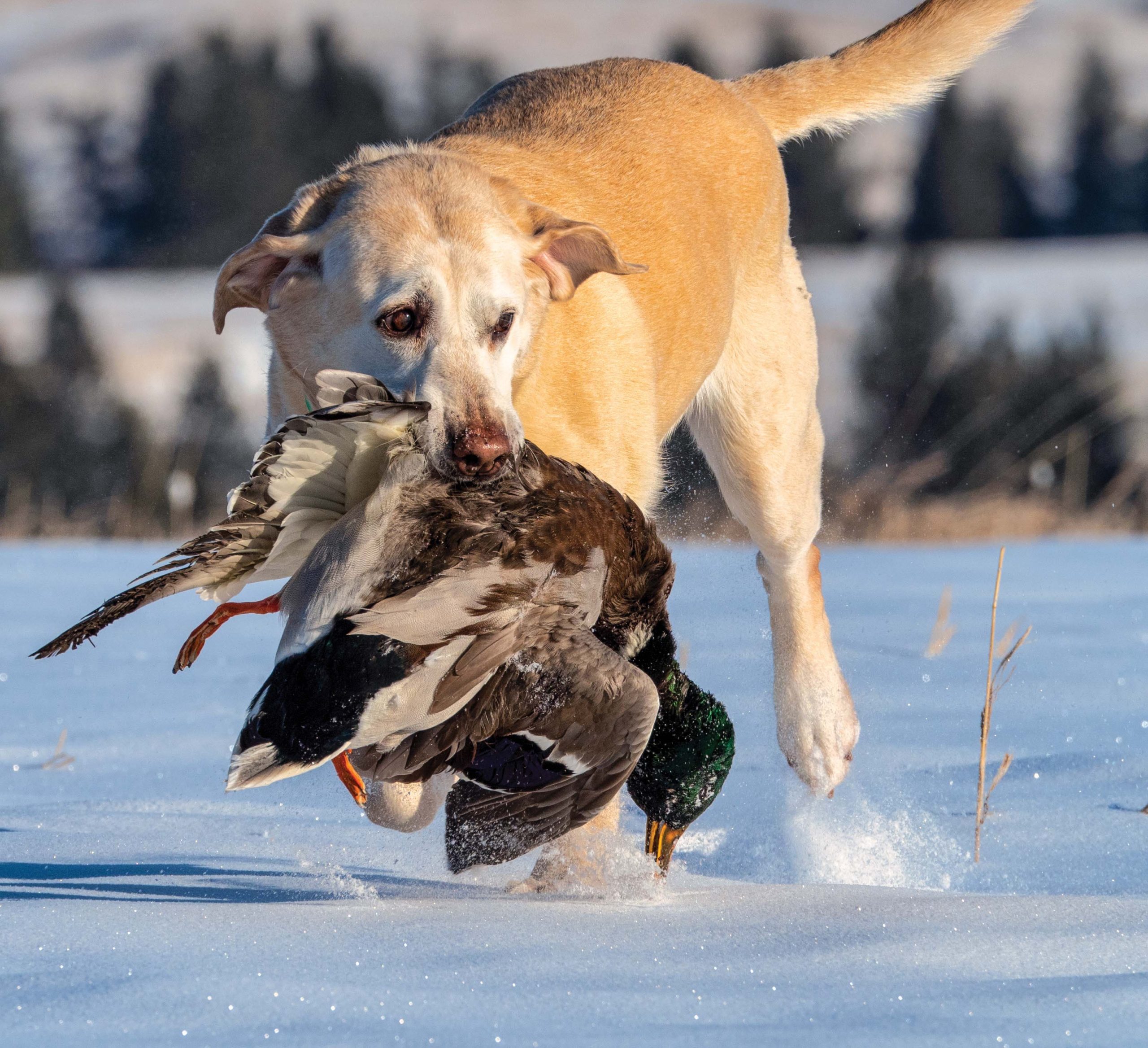
25 Sep Excursion: Big Sky Waterfowl
Moisture rising from the little spring-fed pond overnight had condensed, frozen, and crystallized on the willows lining the bank. The December sun didn’t offer much warmth, but it made the hoarfrost sparkle brilliantly in the clear morning air. The temperature was so cold that I’d had to kick an ice shelf away from the water’s edge before setting out my decoys. Although I’d barely left the truck, I was already stamping my waders to maintain feeling in my toes. Fortunately, Labrador retrievers are hardy, cold-tolerant dogs. Rosy, my yellow female, looked more comfortable than I felt.
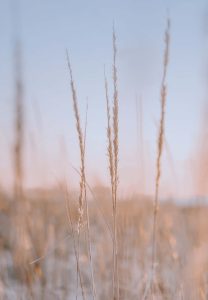
Duck hunting over decoys inevitably demands waiting. In contrast to hunting big game or upland birds, there’s no useful way to attain results by pushing yourself harder. Newly arrived from the Canadian prairie, plump northern mallards had been feeding in nearby stubble fields all night beneath a full moon. The dog and I were standing beside one of the few open ponds in the area, to which ducks were bound to return sometime that morning. Our challenge was to endure the cold long enough to be there when they did.
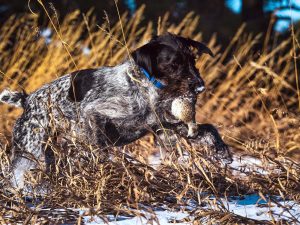
Good duck dogs don’t have to come from the classical retrieving breeds. Max, the author’s male German wirehair, is eagerly fetching a late season teal.
Mallards resting on water communicate by quacking loudly, but when they’re commuting, they chatter softly with one another as if they’re trying to share a secret. Thanks to the amplifying acoustics of frigid air, I heard the inbound flock long before I saw it. A veteran of six busy waterfowl seasons, Rosy knew what the sound meant and gazed intently in that direction. Her eyes were better than mine, and when she began to quiver, I knew she’d spotted ducks silhouetted against the sunrise.
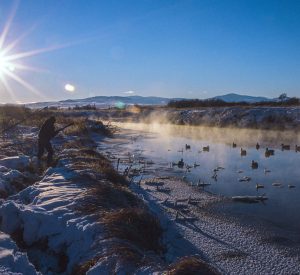
Decoys are illuminated in the morning sun on a spring-fed creek in sub-zero weather.
The birds were still beyond shotgun range when they cupped their wings and began to descend. Since they obviously had the open water locked on their radar, I didn’t bother with the duck call hanging from my neck. As the sound of wind whistling through locked primary flight feathers filled the air, I pivoted slowly into position to receive our arriving guests.
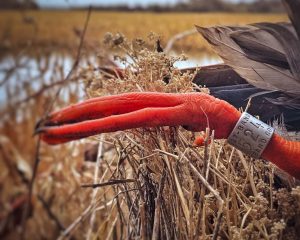
The U.S. Fish & Wildlife Service bands migratory waterfowl to monitor their populations and habitat. If you shoot a banded bird, reporting the band number will provide important data. You will also learn where the bird was banded.
Lay of the Land
Given the reputation Montana’s big-game hunting opportunities enjoy, it’s easy to overlook all that shotguns, retrievers, and decoys can bring to the autumn agenda. A self-evident component of waterfowl habitat, water can be scarce in the semi-arid steppe east of Montana’s Rocky Mountain Front. We may lack the vast wetland habitat that makes Arkansas’ flooded timber and California’s Central Valley rice fields famous waterfowl destinations, but in the right place at the right time, Big Sky duck hunting can be equally fulfilling.
Montana’s northern border traverses the edge of the Canadian Prairie provinces’ pothole region, the most productive waterfowl habitat on the continent. Public wetlands like the Freezout Lake Wildlife Management Area northwest of Great Falls and the Bowdoin National Wildlife Refuge east of Malta churn out a lot of ducks. Scattered prairie marshes and ponds contribute on a smaller scale. Hunting for locally hatched ducks can be excellent from the opening day of duck season in early October until most water starts to freeze several weeks later.
The early waterfowl season offers advantages and disadvantages compared to what lies ahead. Warm weather eliminates the need to dress like polar explorers. For hunters who enjoy variety, there’s never a better time to watch every species of puddle duck in the West circle the decoys, from speedy teal to elegant pintails. However, ducks are more widely dispersed and less abundant than they will be once migrating birds arrive from the north. Younger ducks may still be studded with pinfeathers, which make them hard to clean, and their lean meat isn’t as succulent as it will become later in the season.
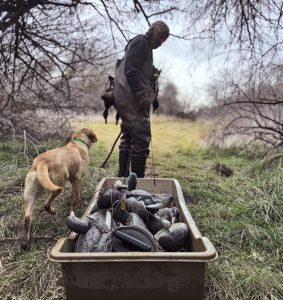
Hauling out a load of decoys with a hardworking young dog is worth the effort, especially when it includes the hunter’s limit of mallards.
Waterfowl hatched in the potholes north of the border inevitably cross Montana on their annual southern journey, creating a brief but spectacular window of opportunity for duck hunters. When I lived in the northeastern corner of the state, I learned to anticipate the day in late October when every pond in the county was suddenly covered in migrating ducks. But nature both giveth and taketh away, and once standing water becomes locked in ice, the birds are often gone overnight. While most of the annual northern hatch eventually overflies the state, those that don’t will concentrate on what open water remains in spring-fed creeks and ponds, as well as larger rivers like the Yellowstone and Missouri. Find the water, and you will find the waterfowl.
Late-season duck hunting offers its own challenges and rewards. When you do find ducks, you will likely have found a lot of them. Almost all will be mallards. Most hunters regard that as a nice problem to have, given the greenheads’ large size and excellent table quality, but I still miss the uncertainty about what will settle among the decoys next. Winter weather creates a paradox. The warmer the temperature, the slower the shooting will be. The trick is to treat zero-degree duck hunting as a character-building experience.
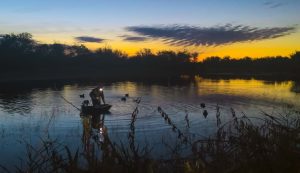
Placing decoys before dawn is an important part of the duck-hunting ritual.
The 1918 Migratory Bird Treaty Act — one of hunters’ greatest contributions to American wildlife conservation — replaced an illogical patchwork of state regulations by making the federal government responsible for managing birds that crossed state lines, especially waterfowl. Today, the U.S. Fish & Wildlife Service (US FWS) establishes waterfowl hunting regulations, including seasons and limits. Four waterfowl Flyways — Atlantic, Mississippi, Central, and Pacific — cross the country from north to south, and the US FWS sets different rules for each prior to every duck season. While scientifically logical, this system can be confusing in states like Montana, where the somewhat arbitrary boundary between the Central and Pacific flyways runs down the middle of the state. What’s legal in one county may not be in an adjoining county. So, a caveat: Know which flyway you’re hunting in and read the regulations carefully.
A Hunter’s Companion
During six decades of waterfowl hunting, I enjoyed no aspect of the experience more than my relationship with the dogs that accompanied me. Part of that enthusiasm is practical. A trained retriever allows hunting over water from which it would otherwise be impossible to recover downed birds. My trained Labs meant more ducks by the time I picked up the decoys and, even more importantly, because of the outdoor values with which I was raised, fewer unrecovered birds. As important as those considerations are, my dogs have always meant more to me. They provide companionship before, during, and after hunting season, share countless hours of teamwork while training and hunting, and become members of my family.
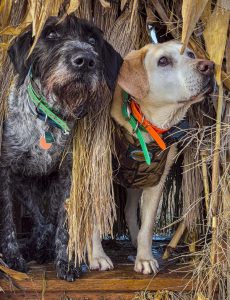
Well-trained duck dogs will sit patiently in a blind, waiting for the birds to arrive. Here, Max and Rosy are busy scanning the sky.
A number of breeds can serve these purposes, including Chesapeake Bay and golden retrievers. Although primarily intended for upland game, several of my German wirehaired pointers performed well in water. However, most of my duck dogs have been Labrador retrievers, an excellent choice for novices and veterans alike because of their intelligence, hardiness, and engaging personalities. I once nominated them as Montana’s unofficial state dog and literally would not go duck hunting without one.
In the Kitchen
Few game cookery topics arouse more differences of opinion than waterfowl. Some hunters, including me, consider properly roasted mallards a culinary delight, while other successful hunters struggle to make the same birds into sausage or jerky. Many in the second category formed their opinions based on the usual culprit in the mismanagement of wild game meant for the table: overcooking. Rich and red, wild duck is nothing like domestic poultry. While the breast meat can be cut up and prepared in any number of ways, from stir-fry to stew, prime mallards deserve to be roasted whole. Cook them like beef and aim for an internal temperature of 135 to 140 degrees Fahrenheit. As with most wild game, the best results will come from ducks that have hung in a cool, dry place for several days before cooking.
The Reward
Cold fingers and toes forgotten, I thumbed my safety and rose to my feet as mallards began to settle over the decoys. Paradoxically, my first priority wasn’t shooting a duck but not shooting one. Regulations allowed a six-bird limit to include no more than two hens and no more than five mallards, but like most responsible hunters, I take pains to avoid shooting the future of the next spring hatch. Bright morning sunlight made the distinction easy; the shooting wasn’t technically difficult, and two shots left a pair of greenheads floating on the surface of the pond. Many duck hunters choose a pump or auto-loading shotgun for the third shot it provides (federal regulations prohibit hunting ducks with higher-capacity firearms), but I decided years ago that if I couldn’t get it done with two, it was time to stop shooting. Stubborn and old-fashioned, I’ve stuck with traditional double-barrels ever since.
The dead birds were barely 20 yards from the shoreline, but prior experience had taught me how treacherous wading the pond’s muddy, snag-filled bottom could be. Rosy’s hour had finally arrived. Trained to stay seated at my side until told otherwise, she was now quivering in anticipation of the command she’d waited for all morning. The single syllable “Fetch!” was all she needed. After leaping across the shoreline ice shelf in one bound, she hit the water in a geyser of spray and churned toward the nearest fallen drake like a canine version of Michael Phelps in an Olympic pool. Having raised and trained her myself, I derived more satisfaction from her performance than from the two shots that preceded it.
An hour later, I was walking back to the truck with Rosy at my side. The five mallard drakes hanging from the strap across my shoulder would soon become Christmas dinner for family and friends.
A Life List of Birds
One does not need to share my enthusiasm for shotguns and retrievers to enjoy Montana waterfowl. While our continental duck population’s recovery from its near-catastrophic nadir in the early 20th century was largely hunter driven, we’re happy to share the results with others. Good duck habitat is also home to the dozens of other waterbird species that inhabit the state. A summer day in one of the wetlands mentioned earlier offers a great opportunity to work on one’s life list of birds, enjoy wildlife photography opportunities, or simply watch nature on display.
No such opportunity is more spectacular than the annual spring snow-goose migration through Freezeout Lake. For complex reasons, the continental snow-goose population is exploding. During the spring migration north via the Pacific Flyway, vast numbers visit Freezeout. On the right day in March, a visitor would find it hard to imagine more geese in one place, anywhere. Serious birders should note that it’s not just about the hundreds of thousands of white geese; over 200 avian species have been recorded at Freezeout. Peak migration timing varies from year to year, but websites from the Audubon Society and Montana Fish, Wildlife, & Parks track current information.
A retired internist, Don Thomas spent his medical career on the Fort Belknap and Fort Peck reservations, in rural Alaska, and in Lewistown, Montana, where he now lives with his wife, Lori Thomas. He has written about the outdoors professionally for 40 years. A fourth-generation Montanan and retired nurse, Lori now handles most of the photography that accompanies his work.



No Comments